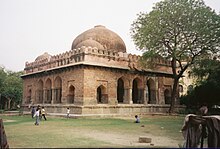
Humayun's tomb is the tomb of Mughal emperor, Mirza Nasir al-Din Muhammad commonly known as Humayun situated in Delhi, India. The tomb was commissioned by Humayun's first wife and chief consort, Empress Bega Begum under her patronage in 1558, and designed by Mirak Mirza Ghiyas and his son, Sayyid Muhammad, Persian architects chosen by her. It was the first garden-tomb on the Indian subcontinent, and is located in Nizamuddin East, Delhi, close to the Dina-panah Citadel, also known as Purana Qila, that Humayun found in 1538. It was also the first structure to use red sandstone at such a scale. The tomb was declared a UNESCO World Heritage Site in 1993, and since then has undergone extensive restoration work, which is complete. Besides the main tomb enclosure of Humayun, several smaller monuments dot the pathway leading up to it, from the main entrance in the West, including one that even pre-dates the main tomb itself, by twenty years; it is the tomb complex of Isa Khan Niazi, an Afghan noble in Sher Shah Suri's court of the Suri dynasty, who fought against the Mughals, constructed in 1547 CE.

Lodi Gardens is a city park situated in New Delhi, India. Spread over 90 acres (360,000 m2), it contains Mohammed Shah's Tomb, the Tomb of Sikandar Lodi, the Shisha Gumbad and the Bara Gumbad, architectural works of the 15th century by Lodis - who ruled parts of northern India and Punjab and Khyber Pakhtunkhwa province of modern-day Pakistan, from 1451 to 1526. The site is now protected by the Archaeological Survey of India (ASI).

Mehrauli is a neighbourhood in South Delhi, Delhi, India. It represents a constituency in the legislative assembly of Delhi. The area is close to Gurugram and next to Vasant Kunj.
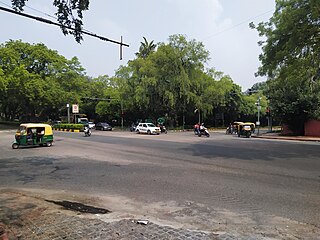
Lodhi Road in New Delhi, India, is named after the Lodhi Gardens located on it. Two Mughal mausoleums, Humayun's Tomb and Safdarjung's Tomb, lie at the eastern and western ends of the road respectively. A number of cultural, educational, and international institutions line the road. The Jor Bagh metro station lies under Aurobindo Marg near its intersection with Lodhi Road. Also located near it are Lodhi colony and Lodhi Estate built during British Raj in 1940s, and Lodhi Road Institutional Area.

Hazrat Nizamuddin Dargah is the dargah (mausoleum) of the Sufi saint Khwaja Nizamuddin Auliya. Situated in the Nizamuddin West area of Delhi, the dargah is visited by thousands of pilgrims every week. The site is also known for its evening qawwali devotional music sessions.
Sohna is a town and a municipal council in the Gurugram district of Haryana, India. A popular tourist weekend and conference retreat, it is on the highway from Gurugram to Alwar near a vertical rock. Sohna is known for its hot springs and Shiva temple. Sohna tehsil is part of Ahirwal Region. Major communities in Sohna are Rajputs, Ahirs, Gujars, Jats, and Muslim Gujjar. Gurugram district is divided into 4 sub-divisions each headed by a Sub-Divisional Magistrate (SDM): Gurugram, Sohna, Pataudi and Badshahpur.

The Indian National Trust for Art and Cultural Heritage (INTACH) is a non-profit charitable organisation registered under the Societies Registration Act, 1860.

Chausath Khamba, also spelled Chaunsath Khamba, is a tomb built during 1623–24. It is located in Nizamuddin precincts of Sufi Muslim shrines and tombs in New Delhi, India. The name means "64 pillars" in Urdu and Hindi. It was built by Mirza Aziz Koka, son of Ataga Khan, as a mausoleum for himself, at the time when Mughal Emperor Jahangir ruled from Delhi. Mirza Aziz Koka had served several times as Jahangir’s Governor of Gujarat before he died in Gujarat.

Sultan Ghari was the first Islamic Mausoleum (tomb) built in 1231 AD for Prince Nasiruddin Mahmud, eldest son of Iltumish, in the "funerary landscape of Delhi" in the Nangal Dewat Forest, Near Nangal Dewat Vasant Kunj).

Jahanpanah was the fourth medieval city of Delhi established in 1326–1327 by Muhammad bin Tughlaq (1325–51), of the Delhi Sultanate. To address the constant threat of the Mongols, Tughlaq built the fortified city of Jahanpanah subsuming the Adilabad fort that had been built in the 14th century and also all the establishments lying between Qila Rai Pithora and Siri Fort. Neither the city nor the fort has survived. Many reasons have been offered for such a situation. One of which is stated as the idiosyncratic rule of Mohammed bin Tughlaq when inexplicably he shifted the capital to Daulatabad in the Deccan and came back to Delhi soon after.

Green Park is an upscale affluent neighborhood in South Delhi, India. The locality is divided into two parts i.e. Main and Extension. The neighbourhood registered a 4.4% growth in residential sales and was featured alongside Greater Kailash, Defence Colony, Vasant Vihar and Anand Niketan in the 2019 edition of Knight Frank's quarterly report on prime luxury residential properties in various megacities around the globe. Property rates have always been high in this colony due to the numerous facilities available. Builder floors and independent villas cost anywhere between INR 6–70 crores in this colony. Rental rates are also very high making this residential area among the most expensive pin codes of New Delhi.

Jamali Kamali Mosque and Tomb, located in the Archaeological Village complex in Mehrauli, Delhi, India, comprise two monuments adjacent to each other; one is the mosque and the other is the tomb of Jamali and Kamali. Their names are tagged together as "Jamali Kamali" for the mosque as well as the tomb since they are buried adjacent to each other. The mosque and the tomb were constructed in 1528-1529, and Jamali was buried in the tomb after his death in 1535.

The Gates of Delhi were city gates at various medieval townships around Delhi, built under dynastic rulers in the period that could be dated from the 8th century to the 20th century. They are the gates in:
Jangpura is a neighbourhood in South East Delhi district of Delhi. Beginning from the east and moving clockwise, it is bordered by the Mathura Road, Ring Railway line, Silver Oak Park beyond the Defence Colony Flyover, and the Barapulla Nullah. It encompasses the residential areas of Jangpura A and B on either side of the Mathura Road, Jangpura (Bhogal) extending west from the Mathura Road until Jangpura Extension, which in turn extends along the northern side of the Ring Railway line to the east side of the Defence Colony Flyover on Josip Broz Tito Marg. The small colony of Pant Nagar along the Barapulla Nullah is contiguous with Jangpura Extension.

Mehrauli Archaeological Park is an archaeological area spread over 200 acre in the Mehrauli neighbourhood of the South Delhi district of Delhi, India, adjacent to the Qutub Minar and the Qutb complex. It consists of over 100 historically significant monuments. It is the only area in Delhi known for 1,000 years of continuous occupation, and includes the ruins of Lal Kot built by Tomar Rajputs in 1060 CE, making it the oldest extant fort of Delhi, and architectural relics of subsequent period, rule of Khalji dynasty, Tughlaq dynasty, Lodhi dynasty of Delhi Sultanate, Mughal Empire, and the British Raj.
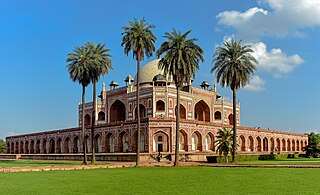
Ratish Nanda is a noted Indian conservation architect, who is the Projects Director of Aga Khan Trust for Culture, India.
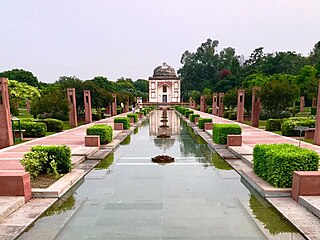
Sunder Nursery, formerly called Azim Bagh or Bagh-e-Azeem, is a 16th-century heritage park complex adjacent to the Humayun's Tomb, a UNESCO World Heritage Site in Delhi. Originally known as Azim Bagh and built by the Mughals in the 16th century, it lies on the Mughal-era Grand Trunk Road, and is spread over 90 acres. Future plans aim to link nearby areas to develop it into India's largest park covering 900 acres.
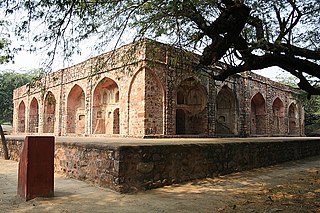
Tombs of Battashewala Complex is an Archaeological Survey of India (ASI) protected monument in Nizamuddin East, Delhi. The funerary complex, consists of three Mughal period tombs, known as the Bara Batashewala Mahal, the Chota Batashewala Mahal, an unidentified Mughal tomb and arched compound wall enclosures.

The Baolis of Mehrauli are four stepwells approached through single stage or three stage steps, located in Mehrauli in Delhi, India, in the Mehrauli Archaeological Park mainlined by the Archaeological Survey of India. These are the Anangtal Baoli, the Gandhak Ki Baoli, and the Rajon Ki Baoli. These were built below the ground level as ground water edifices and were built near shrines in medieval times.
